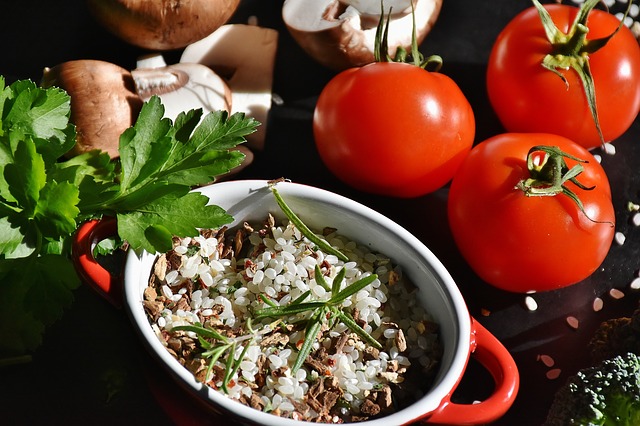Article
Good Carbs, Bad Carbs
Scorned, rejected, and maligned, the earthly carbohydrate is totally misunderstood. There is a story going around that carbs need to be avoided in order for us to stay fit. Many popular diets have made carbohydrates an unwanted nutrient and spawned a trend that minimizes their importance. Look out! This is a dangerous way of thinking because consuming carbohydrates is actually needed for good health.
Who can resist a nice bowl of steaming oatmeal sweetened with maple syrup and garnished with raisins, cashews, and walnuts on a cold winter morning? At home, my family yearns for my stir-fried brown rice, tofu and vegetable dinner entrée. It’s different each time I prepare it, depending on the vegetables I have handy. When you combine high carbohydrate foods (the oatmeal and the brown rice) with proteins (nuts and tofu) you create well balanced, nutritious meals.
As some of you may remember learning in biology class, we need to consume all of the major nutrients in our diet: water, protein, fats, and carbohydrates. In addition, we also need vitamins and minerals, but they are considered to be micronutrients. In order for our bodies to function efficiently, we need to eat all the nutrients, including carbohydrates.
You will see how I take a different approach to the false carb story. Many foods known to be high in carbohydrates are totally wholesome. The trick is in knowing which ones to choose and to keep the serving size small. I will discuss important facts that will help you enjoy these delicious foods in a beneficial way. First, we need to differentiate between good carbs and bad carbs. Second, we need to look at the size of our servings. Even when something is good for you, eating too much can make that food harmful.
New research in the area of nutrition is providing information on how these unique nutrients get digested. A lot goes on inside our bodies when we eat foods that are high in carbohydrates. This is an important part of the story which is worthwhile understanding.
Found mostly in foods from the plant kingdom, carbohydrates supply the body with energy. They can be classified as simple or complex. Simple carbs are digested quickly and include fructose (fruit sugar), sucrose (table sugar) and lactose (milk sugar). Fruit and berries are considered to contain simple carbs. Complex carbohydrates contain sugar molecules that are strung together to form more complex chains. A complex carbohydrate would contain fiber and starch as opposed to simple sugars and take longer to digest. Examples of these are legumes, whole grains and many vegetables.
Both simple and complex carbs are converted to blood glucose which fuels our body’s cells and is the only source of energy for the brain. See how important these nutrients are? Extra glucose gets stored in the liver for future use. But when the consumption of carbohydrates is way over the body’s energy needs, it is then stored as fat. Now all kinds of problems can occur.
When too many carbs are consumed, blood glucose is raised. The pancreas then releases the hormone insulin in order to lower these glucose levels. When insulin is released, it promotes the accumulation of fat in the body. If this happens a lot, you will be stuck in a vicious cycle of eating too many carbs (or eating the wrong ones), releasing insulin, storing fat, and increasing levels of cholesterol. You will have a hard time losing weight and may risk diabetes. Obesity and diabetes have become serious problems in our country.
We need to get used to eating smaller portions. One healthy serving is one slice of whole wheat bread, not a gigantic white flour bagel. Think of all the unnecessary calories that you are consuming when you eat that bagel. If you must, just eat half of it.
The next time you go food shopping, look for whole grain choices. But be sure to read the label and look at the fiber content. The higher the fiber, the better it will be. Highly processed foods tend to be lower in fiber. Think of it as a continuum of processing, which begins with foods that are not processed, moves on to slightly processed and then to highly processed.
At the least processed end is the entire grain, such as the wheat berry, brown rice, or oat groats. You can eat these whole grains at breakfast or as side dishes at dinner time. These unprocessed grains are made up of complex carbohydrates and are very high in fiber. At the opposite end of our continuum, the highly processed grains have now become white flour products which can raise blood sugar levels as soon as you are done with the meal.
Eating carbs that are complex, unprocessed, and high in fiber will prevent blood sugar from spiking. They are digested much more slowly. Choose these good carbs and stay away from the bad ones. Experiment by cooking brown rice, barley, millet, whole wheat, rye, oats and buckwheat groats. Most of the time, these grains are all cooked in the same manner. Begin by rinsing one cup of the grain. In a pot, add the rinsed grain of your choice to two cups of water, a pinch of salt and a bit of olive oil. Bring the water to a boil, cover and then simmer for about 30 to 45 minutes. Be sure not to stir until the very end of the grain will get too mushy.
Complicating the story is the concept of the glycemic index. You may have heard this term mentioned before. As we get more scientific information about nutrition, our knowledge grows. The glycemic index (GI), is a numerical system that measures how much of a rise in blood sugar is triggered by eating carbohydrates. The higher the number, the greater the spike in blood sugar. For example, corn scores very high in the glycemic index. If you are concerned about blood sugar levels, corn should go on your “eat only sometimes” list.
Remember, I mentioned that when blood sugar goes up, insulin is released and extra carbs are stored as fat. Excess insulin stimulates the liver to make more cholesterol, which is not a good thing. Knowing the glycemic index of foods makes it possible to know which foods to avoid and thus prevent excess cholesterol to be produced.
But that is not the whole story; a new measurement is now being touted as even more important. It’s called the glycemic load (GL). Some people think this gives a better picture because it takes into account the amount of carbohydrate in that food. There are foods with a high glycemic index, but they may not be harmful because they may contain a very small amount of the culprit carbohydrate.
While doing research for this article, I noticed that tapioca has a very high glycemic index, but a low glycemic load. In other words, the carbohydrates in this cereal can raise blood sugar to unhealthy levels, but because there is a small amount of these carbs in the tapioca, the glycemic load is low, so it is safe to eat.
Another great way of keeping warm this fall and winter is by eating wholesome ancient grains. These unique traditional foods are extremely nutritious and will provide much-needed variety in our diets. We are too used to eating bread and other flour products as our grains. Explore the ancient foods of other cultures.
Amaranth was the staple diet of the Aztecs who believed it helped them achieve supernatural powers. One of the few plant foods that are a complete protein, Amaranth contains all of the essential amino acids. Quinoa was also thought to be sacred by the Incas. It has a nutty flavor and a creamy consistency once it’s cooked.
More commonly known, spelt is a cousin to wheat. You will find many wheat-free products made with spelt flour. Kamut, another relative of wheat, is a grain that is higher in protein than wheat.
Get away from the habit of eating bread at every meal, substitute a different whole grain and see how you feel. You may have boundless amounts of energy….
Check these Websites and learn more about what to look for in good tasting, good quality foods in variety:
www.goodcarbs.org , www.glycemicindex.com
_____________________________________
Julie Gerber, M. Ed. is a Licensed Nutrition Counselor. A health and wellness columnist, Julie is the vice president of Marketing at BeeCeuticals Organics, a natural body care company.
Share article











You must be logged in to add a comment ... → Log in | Register